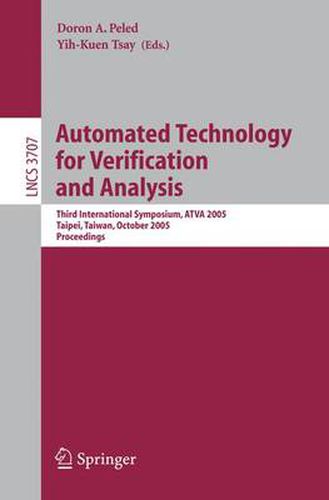Readings Newsletter
Become a Readings Member to make your shopping experience even easier.
Sign in or sign up for free!
You’re not far away from qualifying for FREE standard shipping within Australia
You’ve qualified for FREE standard shipping within Australia
The cart is loading…






This title is printed to order. This book may have been self-published. If so, we cannot guarantee the quality of the content. In the main most books will have gone through the editing process however some may not. We therefore suggest that you be aware of this before ordering this book. If in doubt check either the author or publisher’s details as we are unable to accept any returns unless they are faulty. Please contact us if you have any questions.
The Automated Technology for Veri?cation and Analysis (ATVA) international symposium series was initiated in 2003, responding to a growing interest in formal veri?cation spurred by the booming IT industry, particularly hardware design and manufacturing in East Asia. Its purpose is to promote research on automated veri?cation and analysis in the region by providing a forum for int- action between the regional and the international research/industrial commu- ties of the ?eld. ATVA 2005, the third of the ATVA series, was held in Taipei, Taiwan, October 4-7, 2005. The main theme of the symposium encompasses - sign, complexities, tools, and applications of automated methods for veri?cation and analysis. The symposium was co-located and had a two-day overlap with FORTE 2005, which was held October 2-5, 2005. We received a total of 95 submissions from 17 countries. Each submission was assigned to three Program Committee members, who were helped by their subreviewers, for rigorous and fair evaluation. The ?nal deliberation by the P- gram Committee was conducted over email for a duration of about 10 days after nearly all review reports had been collected. In the end, 33 papers were - lectedforinclusionintheprogram.ATVA2005hadthreekeynotespeechesgiven respectively by Amir Pnueli (joint with FORTE 2005), Zohar Manna, and Wo- gang Thomas. The main symposium was preceded by a tutorial day, consisting of three two-hour lectures given also by the keynote speakers.
$9.00 standard shipping within Australia
FREE standard shipping within Australia for orders over $100.00
Express & International shipping calculated at checkout
This title is printed to order. This book may have been self-published. If so, we cannot guarantee the quality of the content. In the main most books will have gone through the editing process however some may not. We therefore suggest that you be aware of this before ordering this book. If in doubt check either the author or publisher’s details as we are unable to accept any returns unless they are faulty. Please contact us if you have any questions.
The Automated Technology for Veri?cation and Analysis (ATVA) international symposium series was initiated in 2003, responding to a growing interest in formal veri?cation spurred by the booming IT industry, particularly hardware design and manufacturing in East Asia. Its purpose is to promote research on automated veri?cation and analysis in the region by providing a forum for int- action between the regional and the international research/industrial commu- ties of the ?eld. ATVA 2005, the third of the ATVA series, was held in Taipei, Taiwan, October 4-7, 2005. The main theme of the symposium encompasses - sign, complexities, tools, and applications of automated methods for veri?cation and analysis. The symposium was co-located and had a two-day overlap with FORTE 2005, which was held October 2-5, 2005. We received a total of 95 submissions from 17 countries. Each submission was assigned to three Program Committee members, who were helped by their subreviewers, for rigorous and fair evaluation. The ?nal deliberation by the P- gram Committee was conducted over email for a duration of about 10 days after nearly all review reports had been collected. In the end, 33 papers were - lectedforinclusionintheprogram.ATVA2005hadthreekeynotespeechesgiven respectively by Amir Pnueli (joint with FORTE 2005), Zohar Manna, and Wo- gang Thomas. The main symposium was preceded by a tutorial day, consisting of three two-hour lectures given also by the keynote speakers.